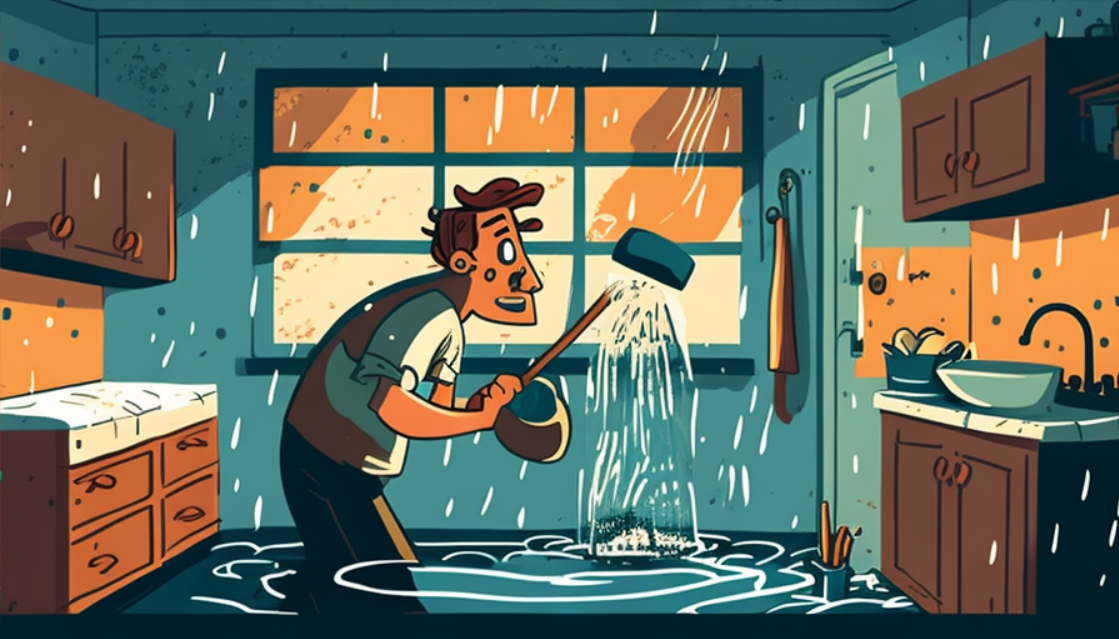Facing a high water mitigation bill can be overwhelming for homeowners, adding stress to an already challenging situation. Whether it’s unexpected costs or concerns about transparency, navigating through this process can be daunting. But fear not, as there are effective strategies to help you manage and address these issues.
In this guide, we’ll explore actionable tips and tactics to assist you in handling a high water mitigation bill, empowering you to take control and find a resolution that works for you.
Table of contents
Review your contract
Before diving into negotiations or disputing charges, it’s crucial to thoroughly review the contract you signed with the water mitigation company. Here’s how to navigate this essential step:
- Pricing and Scope of Services: Carefully examine the contract to understand the pricing structure and the scope of services outlined. Pay close attention to any details regarding pricing per service or per hour, as well as any additional fees or surcharges mentioned.
- Deviation and Scope Creep: Compare the terms of the contract with the actual services provided. Look for any instances where the company may have deviated from the agreed-upon scope of work or added services without your consent. These deviations could be potential areas for negotiation or dispute.
- Communication Channels: Note the designated channels for communication with the company, such as phone numbers, email addresses, or online portals. Keep track of all communication related to the contract, including emails, phone calls, and in-person meetings.
- Documentation: Document any discrepancies or concerns you have with the contract. If there are ambiguities or unclear terms, seek clarification from the company in writing. Having a clear record of your concerns will be invaluable if you need to escalate the issue later on.
- Record Keeping: Maintain a detailed record of all interactions with the water mitigation company, including dates, times, and summaries of conversations. This documentation will serve as evidence in case of any disputes or legal proceedings.
By thoroughly reviewing your contract and understanding its terms, you’ll be better equipped to address any discrepancies or issues with the water mitigation company. This proactive approach sets the stage for effective communication and resolution moving forward.
Request an itemized invoice
When faced with a water mitigation bill that exceeds expectations, requesting an itemized invoice is a proactive step towards clarity and transparency. Here’s how to navigate this process effectively:
- Initiate the Request: Reach out to the water mitigation company and formally request an itemized invoice detailing the charges associated with the services provided. Clearly communicate your need for transparency and understanding regarding the billed amounts.
- Breakdown of Charges: Once you receive the itemized invoice, carefully review each charge and service listed. Look for any discrepancies or unfamiliar items that may warrant further clarification. Understanding the breakdown of charges will enable you to pinpoint areas of concern or potential overbilling.
- Unforeseen Complications: Keep an open mind to the possibility of legitimate reasons for the higher bill, such as unforeseen complications or additional services required to address the water damage effectively. Evaluate whether the charges align with the complexity of the mitigation efforts undertaken.
- Identify Unreasonable Charges: If you identify charges that appear unreasonable or unnecessary, highlight these items for further investigation. Cross-reference the invoice with the terms outlined in your contract to determine if the charges are justified based on the agreed-upon scope of work.
- Evidence for Dispute: Use the itemized invoice as concrete evidence to support your dispute of any unjustified charges. Prepare to articulate your objections clearly and provide documentation or correspondence to substantiate your claims.
By requesting an itemized invoice and scrutinizing the breakdown of charges, you gain insight into the factors contributing to your water mitigation bill. This informed approach empowers you to address discrepancies effectively and advocate for fair and transparent billing practices.
Get a second opinion
When grappling with uncertainties surrounding your water mitigation bill, seeking a second opinion can offer invaluable clarity and peace of mind. Here’s how to navigate this process effectively:
- Assess the Situation: If you remain uncertain about the charges or suspect lack of transparency from the initial water mitigation company, consider the merits of obtaining an independent assessment of the damage and associated costs.
- Engage Another Expert: Reach out to a reputable water mitigation company or professional in your area and request an evaluation of the damage. Provide them with relevant details regarding the scope of work performed by the initial company and share the itemized invoice, if available.
- Comprehensive Evaluation: The second opinion provider will conduct a thorough assessment of the damage, considering factors such as the extent of water intrusion, structural integrity, and required remediation efforts. They will then provide an estimate of the necessary repairs and associated costs.
- Comparative Analysis: Upon receiving the second opinion assessment, compare it with the findings and charges outlined in the initial water mitigation company’s evaluation and invoice. Pay close attention to any discrepancies or significant differences in the proposed scope of work and associated costs.
- Informed Decision-Making: Armed with multiple assessments, you can make a more informed decision regarding the reasonableness of the charges and the necessity of the services provided by the initial company. Consider factors such as expertise, credibility, and alignment with industry standards when evaluating the opinions.
- Resolution Path: Depending on the findings of the second opinion, you may choose to negotiate with the initial company based on the new assessment, dispute unjustified charges, or seek alternative avenues for resolving the billing discrepancies.
By seeking a second opinion, you gain an additional layer of insight into the extent of the damage and the reasonableness of the charges, empowering you to make informed decisions and navigate the water mitigation process with confidence.
Negotiate with the water mitigation company
When facing what you perceive as exorbitant charges from the water mitigation company, engaging in negotiations can often yield mutually beneficial outcomes. Here’s how to navigate this crucial step effectively:
- Prepare Your Case: Before initiating negotiations, gather all relevant documentation, including the contract, itemized invoice, and any supporting evidence that validates your concerns about the charges. This may include photographs, correspondence, or expert assessments.
- Initiate Contact: Reach out to the water mitigation company, expressing your desire to discuss the charges associated with the services provided. Clearly articulate your concerns regarding the bill and emphasize your willingness to work towards a fair resolution.
- Present Evidence: During negotiations, present your case methodically, highlighting specific areas where you believe the charges may be unjustified or inflated. Provide evidence to support your assertions, such as comparative quotes from other reputable service providers or industry standards for similar services.
- Propose Alternatives: Offer constructive suggestions for revising the terms of the agreement or reducing the overall cost burden while ensuring that the necessary remediation efforts are still adequately addressed. Propose alternative payment arrangements or compromises that align with both parties’ interests.
- Remain Professional: Maintain a professional and courteous demeanor throughout the negotiation process, refraining from confrontational language or hostile behavior. Demonstrating a willingness to collaborate and find common ground can foster a more constructive dialogue and increase the likelihood of reaching a satisfactory resolution.
- Seek a Win-Win Outcome: Strive for a mutually beneficial outcome where both parties feel their concerns have been addressed and their interests protected. Be open to creative solutions that address your financial constraints while allowing the water mitigation company to uphold its professional standards and obligations.
- Document Agreements: Once negotiations are concluded, ensure that any revised agreements or compromises reached are documented in writing. Clarify the revised terms, including adjustments to the scope of work, pricing, payment schedules, and any other relevant provisions, to avoid future misunderstandings.
By approaching negotiations with a clear understanding of your position, supporting evidence, and a collaborative mindset, you can increase the likelihood of achieving a fair and satisfactory resolution to the billing discrepancies with the water mitigation company.
File a complaint
When all attempts to resolve billing discrepancies with the water mitigation company have proven futile, filing a formal complaint may be necessary. Here’s how to navigate this process effectively:
- Choose the Appropriate Authority: Determine whether the Better Business Bureau (BBB) or your state’s Attorney General’s office is the appropriate entity to address your complaint. Consider factors such as jurisdiction, the nature of the dispute, and the regulatory authority of each organization.
- Gather Documentation: Compile comprehensive documentation to support your complaint, including copies of the contract, itemized invoice, correspondence with the company, and any other relevant evidence. Provide a detailed account of the dispute, including dates, communication records, and attempts at resolution.
- File the Complaint: Follow the established procedures outlined by the BBB or Attorney General’s office for filing a formal complaint. Provide all requested information accurately and thoroughly, ensuring that your complaint is clear, concise, and substantiated by evidence.
- Cooperate with Investigations: If the complaint proceeds to investigation, cooperate fully with any inquiries or requests for additional information from the investigating authority. Be responsive to communications and provide any further documentation or clarification as requested.
- Mediate a Resolution: The BBB or Attorney General’s office may act as a mediator between you and the water mitigation company, facilitating negotiations and seeking a resolution to the dispute. Be open to mediation and actively participate in discussions aimed at reaching a mutually acceptable outcome.
- Monitor Progress: Stay informed about the progress of the complaint investigation and mediation process. Follow up with the relevant authority periodically for updates on the status of your complaint and any developments in the resolution efforts.
- Review Outcomes: Once the complaint process is concluded, review the outcomes and any resolutions reached. Ensure that the agreed-upon terms are documented in writing and that you are satisfied with the outcome before closing the complaint.
By leveraging the resources and oversight provided by external regulatory authorities, such as the BBB or Attorney General’s office, you can escalate your concerns with the water mitigation company to a higher level and seek resolution through official channels.
Contact your insurance company
Your homeowners insurance policy can serve as a valuable resource in navigating unexpected expenses related to water damage mitigation. Here’s how to leverage your coverage effectively:
- Review Your Policy: Take the time to thoroughly review your homeowners insurance policy, paying close attention to provisions related to water damage and mitigation services. Identify any relevant coverage limits, exclusions, or deductible requirements that may impact your ability to seek reimbursement for mitigation expenses.
- Contact Your Insurance Company: Reach out to your insurance provider to initiate a discussion about the water mitigation services you’ve incurred. Provide details about the nature and extent of the damage, as well as the services rendered by the mitigation company. Inquire about the specific coverage available under your policy and whether the incurred expenses qualify for reimbursement.
- Understand Coverage Limitations: Be mindful of any limitations or exclusions outlined in your policy that may affect coverage for water damage mitigation. Factors such as the cause of the damage, the type of coverage you have, and the applicable deductible amount can impact the extent to which your insurance company will cover mitigation expenses.
- Document Communication: Keep thorough records of all communication with your insurance company, including phone calls, emails, and written correspondence. Take note of any instructions, guidance, or commitments provided by your insurer regarding coverage for water mitigation services.
- Submit a Claim if Applicable: If your insurance company confirms coverage for the water mitigation services in accordance with your policy terms, follow their instructions for submitting a claim. Provide any requested documentation, such as invoices, receipts, and proof of payment, to support your claim for reimbursement.
- Adhere to Reporting Deadlines: Be mindful of any deadlines or reporting requirements stipulated by your insurance policy for filing a claim related to water damage mitigation. Failure to adhere to these deadlines could jeopardize your ability to seek reimbursement for incurred expenses.
- Seek Clarification if Needed: If you encounter any confusion or uncertainty regarding your coverage or the claims process, don’t hesitate to seek clarification from your insurance company. Request additional information or explanations to ensure that you fully understand the terms and conditions of your policy.
By proactively engaging with your insurance provider and understanding the coverage available under your policy, you can potentially offset some of the financial burden associated with water damage mitigation expenses.
Consider legal action
When faced with potential misconduct or breaches of contract by a water mitigation company, exploring legal recourse may be necessary to protect your rights. Here’s what to consider before taking legal action:
- Evaluate the Situation: Assess the circumstances surrounding your interaction with the water mitigation company to determine if their actions constitute potential legal violations or breaches of contract. Document any evidence, such as communications, contracts, invoices, and records of services provided, that support your claims of misconduct or non-compliance.
- Consult with Legal Experts: Seek guidance from legal professionals specializing in consumer protection or contract law to discuss the specifics of your situation. A qualified attorney can review the details of your case, assess the strength of your claims, and provide informed advice on the most appropriate course of action to pursue.
- Understand Legal Remedies: Familiarize yourself with the legal remedies available to address grievances against the water mitigation company. These may include filing a lawsuit for breach of contract, pursuing claims of fraud or deceptive practices, or seeking damages for financial losses incurred as a result of the company’s actions.
- Consider Alternative Dispute Resolution: Explore alternative methods of dispute resolution, such as mediation or arbitration, as potential avenues for resolving conflicts with the water mitigation company outside of the courtroom. These approaches may offer more efficient and cost-effective means of reaching a resolution while avoiding the complexities and expenses associated with litigation.
- Assess Potential Costs and Risks: Evaluate the potential costs, risks, and benefits associated with pursuing legal action against the water mitigation company. Consider factors such as attorney fees, court costs, the likelihood of success, and the potential outcomes of litigation when weighing your options.
- Maintain Clear Communication: Throughout the legal process, maintain clear and consistent communication with your attorney and any relevant parties involved in the dispute. Keep detailed records of all correspondence, legal filings, and developments related to your case to ensure transparency and accountability.
- Seek Timely Resolution: Strive to pursue a timely resolution to your legal dispute with the water mitigation company, balancing the need for swift action with thorough preparation and due diligence. Avoid unnecessary delays that could prolong the resolution process and exacerbate the financial and emotional toll of the situation.
By carefully considering your legal options and seeking guidance from experienced legal professionals, you can effectively address concerns related to misconduct or non-compliance by a water mitigation company and seek appropriate remedies to protect your rights and interests.
Closing
Dealing with a high water mitigation bill can be daunting, but by taking proactive steps and exploring your options, you can effectively manage the situation. Whether through negotiation, seeking assistance from your insurance company, or pursuing legal action as a last resort, prioritizing your rights and financial well-being is paramount. Stay informed, assertive, and vigilant in resolving any discrepancies with the water mitigation company, and remember that you are not alone in navigating this challenging process.
FAQ
Start by reviewing your contract with the water mitigation company to understand the charges. Request an itemized invoice to pinpoint where the additional costs are coming from.
If you find the charges to be excessive or unjustified, gather evidence and consider negotiating with the water mitigation company. You can also seek a second opinion from another reputable company.
If negotiations fail, you can file a complaint with organizations like the Better Business Bureau or your state’s Attorney General’s office to seek mediation.
It depends on your policy coverage. Contact your insurance company to understand your policy terms and any limitations or exclusions related to water damage claims.
Legal action should be considered as a last resort if you believe the company has acted in bad faith or violated laws. Consult with a lawyer specializing in consumer protection or contract law to explore your options.




